Mastering Japandi Lighting: 10 Key Illumination Tips and 7 Mistakes to Avoid
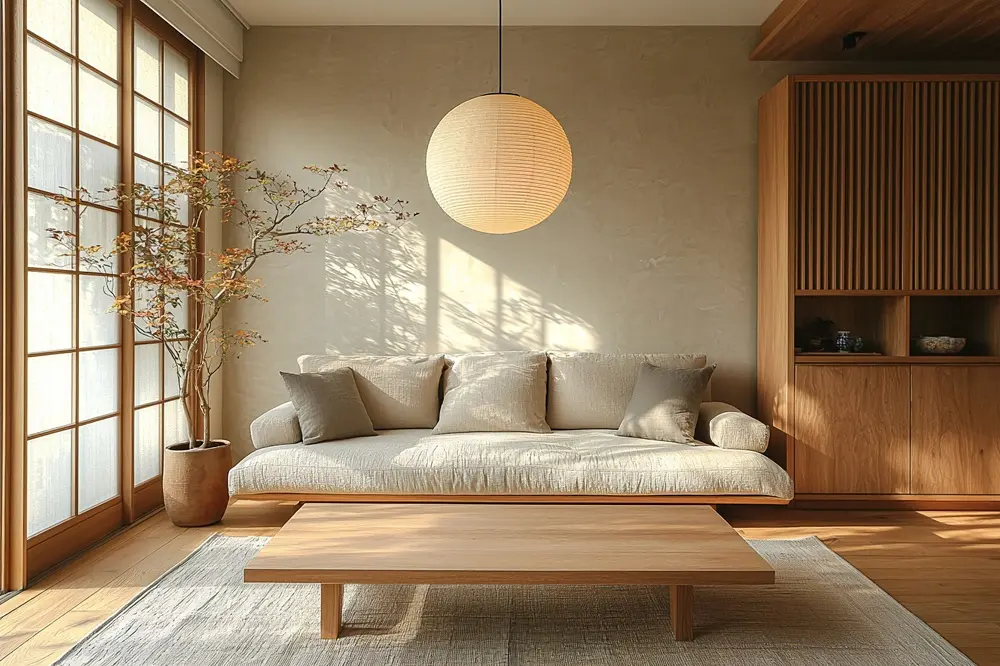
Japandi lighting is an essential design element in creating a serene and balanced atmosphere that defines Japandi interiors. By blending the warmth of Scandinavian design with the tranquility of Japanese aesthetics, this style emphasizes soft, warm-toned illumination with minimalist, functional designs made from natural materials like wood, bamboo, washi paper, and ceramic. Layered lighting combines ceiling, wall, and indirect sources to add depth and dimension, while hidden or diffused lighting prevents harsh glares. The interplay of light and shadow enhances tranquility, making Japandi lighting not just about illumination but a key element in fostering harmony, comfort, and simplicity in a space.
To achieve the perfect lighting atmosphere, it is important to master the techniques that enhance Japandi lighting while avoiding common mistakes. Explore the following 10 essential tips for perfecting Japandi lighting, as well as 7 key pitfalls to avoid. These insights will guide you in creating a space that seamlessly blends beauty, function, and tranquility.
10 Key Features of Japandi Lighting
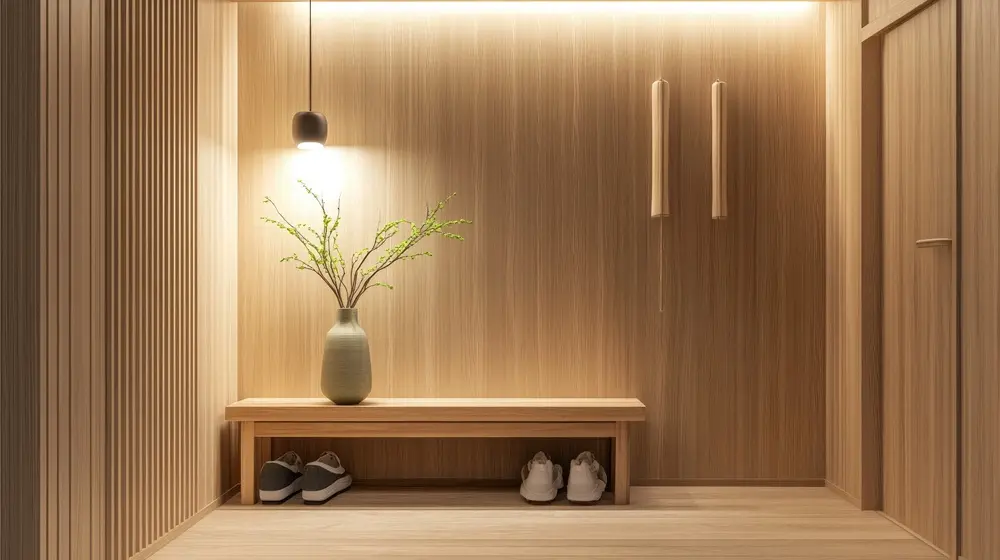
Japandi lighting fosters a tranquil environment that enhances the beauty of the space while maintaining a sense of calm and harmony. Whether through the soft glow of dimmable lights, the subtle interplay of light and shadow, or the use of pendant lights as focal points, Japandi lighting transforms a room into a peaceful haven.
1. Warm and Soft Lighting
Opt for warm-toned LED bulbs (2700K-3000K) or incandescent lights to create a cozy and inviting ambiance. This soft, natural glow aligns with Japandi aesthetics, fostering a sense of calm and relaxation. The soft illumination also minimizes harsh contrasts, creating a harmonious space conducive to unwinding.
2. Layered Lighting
Use a mix of ceiling, wall, and indirect lighting to create a balanced and harmonious atmosphere. By combining different light sources—such as ceiling lights, wall lamps, floor lamps, and indirect lighting—you can create depth and dimension in the space. Layering lighting not only enhances the functionality of the room by providing adequate illumination but also helps define different zones within an open-plan layout. This approach ensures the room feels both airy and intimate at the same time.
3. Hidden & Indirect Lighting
Japandi interiors embrace subtlety, and hidden or indirect lighting plays a major role in this. Concealed lights, such as LED strips behind furniture or wall washes, provide a soft, diffused glow that adds to the tranquil atmosphere without the harsh glare of exposed bulbs. This indirect lighting method enhances the space's Zen-like ambiance, creating a serene mood while maintaining the minimalist aesthetic of Japandi design.
4. Task Lighting for Functionality
Blend form and function with task lighting. Ensure that practical areas, like dining tables, desks, and kitchens, are well-lit with strategically placed task lighting—such as table lamps, sconces, or under-cabinet lights. These fixtures provide the necessary brightness for tasks like reading, cooking, or working, while still aligning with the minimalist, calming principles of Japandi design.
5. Natural Materials
Incorporate materials like wood, bamboo, washi paper, and ceramic to enhance the organic feel of the space. These textures add warmth, authenticity, and a handcrafted touch that embodies the Japandi principle of blending the beauty of nature with functional design. Whether it is a wooden light fixture or a bamboo lamp shade, these materials evoke a sense of craftsmanship and sustainability, essential to the Japandi aesthetic.
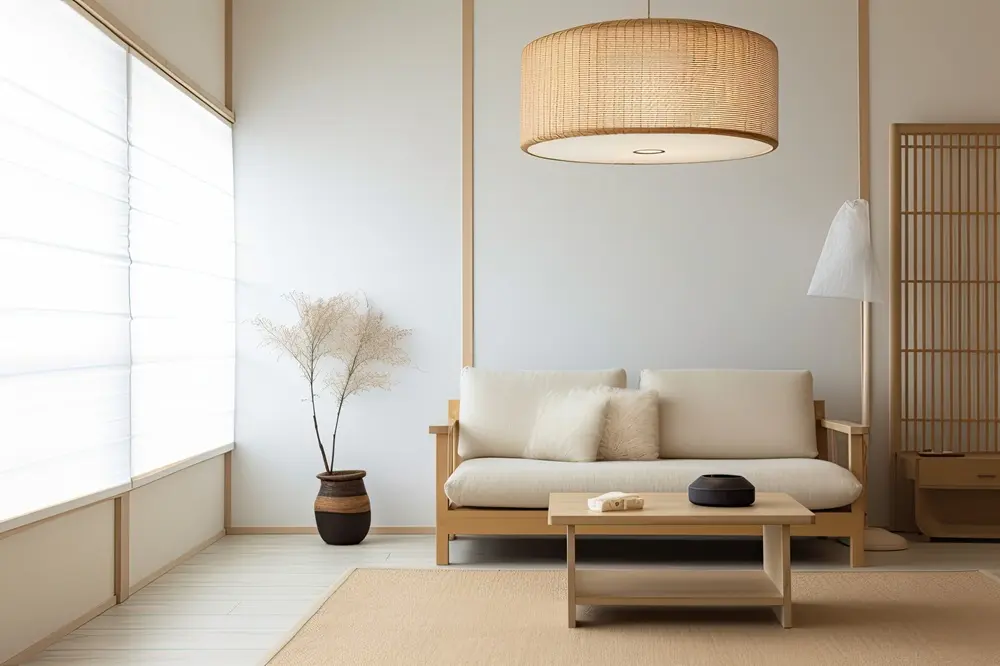
6. Dimmable & Adjustable Lights
Flexibility is key to creating the ideal atmosphere in any Japandi space. Select dimmable fixtures to adjust brightness according to the time of day or the mood you want to set. Whether you are hosting a dinner or unwinding after a long day, being able to soften the lighting or brighten it for tasks ensures that the space serves both functional and aesthetic needs. This adaptability also contributes to the overall calming effect that Japandi lighting aims to achieve.
7. Soft Contrast Between Light and Shadow
The interplay of light and shadow is fundamental to creating a peaceful, meditative atmosphere. Avoid overly bright or flat lighting, embrace gradual transitions of light to create soft contrasts of brightness. This balance between light and shadow adds texture and depth to the space, evoking a calm, Zen-like ambiance that encourages relaxation and mindfulness.
8. Pendant Lights as a Focal Point
Pendant lights, with their simple yet elegant designs, are often used as focal points in Japandi spaces, particularly in dining areas. A well-chosen pendant light can serve as both a functional source of light and a visual centerpiece, adding depth and interest without disrupting the space's harmony.
9. Minimalist & Functional Design
Choose lighting fixtures with simple, uncluttered shapes that blend seamlessly with the space. In Japandi design, functionality is key—each lighting piece should serve a clear purpose while maintaining a clean and elegant look. The minimalist design maintains the calm, unobtrusive feel typical of Japandi interiors, allowing the space to feel open and unburdened.
10. Shoji and Lantern-Inspired Designs
Japandi lighting takes inspiration from traditional Japanese shoji screens and washi paper lanterns, incorporating their soft, diffused glow to create a serene and cozy ambiance. Modern interpretations often use materials like frosted glass, linen fabric, and eco-friendly synthetic paper, achieving the same gentle lighting effect while enhancing durability.
Shoji-inspired lighting features wooden grid frames with rice paper or fabric shades, seen in pendant lights, table lamps, and panel lighting that evenly diffuses light. Wall sconces with wooden slats cast subtle shadows, adding warmth and depth.
Washi-inspired lighting, with Akari lanterns as a well-known example, features round, cloud-like pendant lights, floor and table lamps with paper shades, and clustered suspended lanterns that bring a sculptural, airy feel to interiors.

7 Common Pitfalls in Japandi Lighting and How to Avoid Them
To maintain the serene and harmonious atmosphere essential to Japandi lighting, it is important to steer clear of common oversights that can disturb its tranquil vibe. From harsh, cool-toned lighting to overusing pendant lights, these missteps can compromise the style's minimalist elegance. To create a harmonious space, opt for warm, soft lighting, use layered light sources, and maintain consistent color temperatures. These considerations will help preserve the calm, inviting ambiance that defines Japandi design.
1. Using Cool-Toned or Harsh Blue Lighting
Japandi style thrives on warm, soft lighting to create a cozy and inviting atmosphere. Cool-toned or harsh blue lighting (5000K-6500K) can disrupt this ambiance and make the space feel cold and unwelcoming. Opt for warm-toned LEDs (2700K-3000K) to stay in line with the tranquil, balanced nature of Japandi design.
For example, in a bathroom, overly bright or cool-toned lighting can create a clinical feel rather than a spa-like retreat. To cultivate a soothing atmosphere, opt for warm, layered lighting with wall sconces, backlit mirrors, or recessed LED strips. These elements provide a soft, diffused glow, enhancing relaxation while maintaining the clean, minimalist aesthetic of Japandi design.
Poor: Overly bright and cool-toned lighting
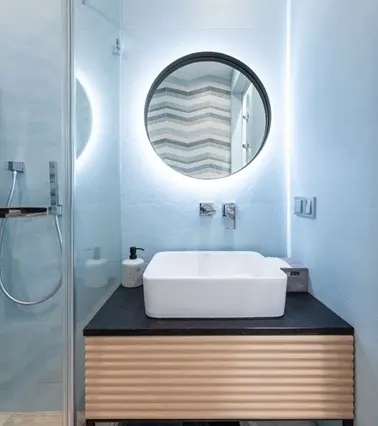
Good: Soft diffused lighting
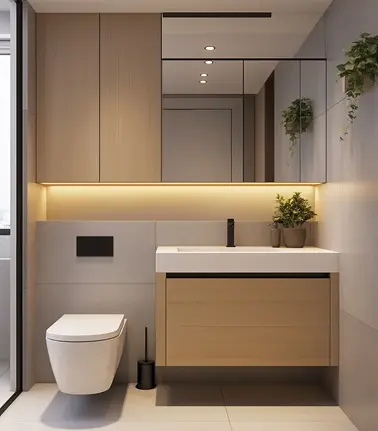
2. Mixing Inconsistent Color Temperatures
Mixing lighting sources with different color temperatures (cool and warm tones) can disrupt the calming atmosphere of a Japandi room. Color temperature consistency is crucial to maintaining cohesion and tranquility throughout the room. Stick to a uniform, warm light for all your lighting fixtures to ensure that the space retains a peaceful and harmonious feel.
To maintain the peaceful vibe, it is essential to choose lighting fixtures that emit a consistent color temperature, ideally warm (2700K-3000K). In a dining room, for instance, using warm-toned bulbs in both overhead lighting and accent lamps ensures a fluid, cohesive environment that fosters relaxation. By sticking to this warm tone across all lighting sources—whether it's the ceiling light, table lamps, or sconces -you create a unified, harmonious space that feels inviting and balanced.
3. Relying Solely on Overhead Lighting
Overhead lighting, while functional, can create flat, unflattering illumination that lacks depth and warmth. To achieve the harmonious balance characteristic of Japandi interiors, adopt a layered approach to lighting by combining ceiling, wall, and indirect light sources. Incorporating wall lamps, floor lamps, and subtle, indirect lighting adds depth to the room, preventing it from feeling stark or overly bright, and contributes to a more welcoming and visually appealing space.
4. Overusing Pendant Lights
While pendant lights can be a focal point, overusing them can create clutter and disrupt the minimalist, airy vibe of Japandi interiors. Use pendant lights sparingly and ensure they complement the space's overall aesthetic, rather than overpowering the space.
For instance, in a kitchen, an excessive number of pendant lights might create visual clutter and disrupt the clean, functional aesthetic. A better approach would be to combine recessed lighting for overall illumination with under-cabinet lights or a few well-placed pendant lamps, ensuring a bright yet balanced atmosphere.
Poor: Overcrowded with pendant lights
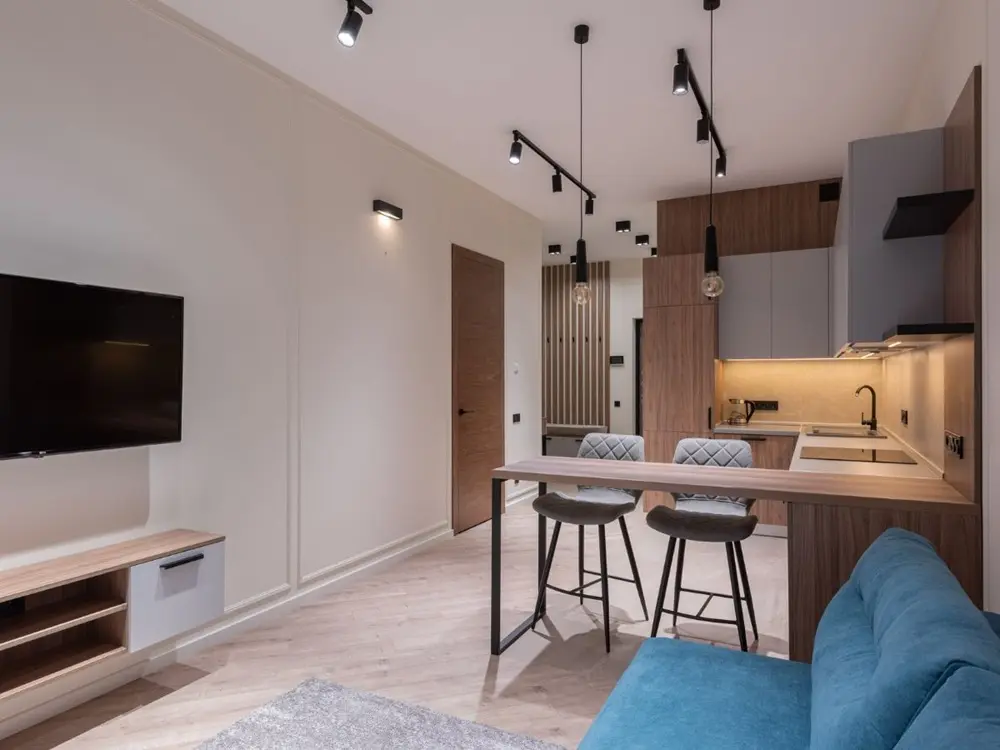
Good: Bright and balanced lighting
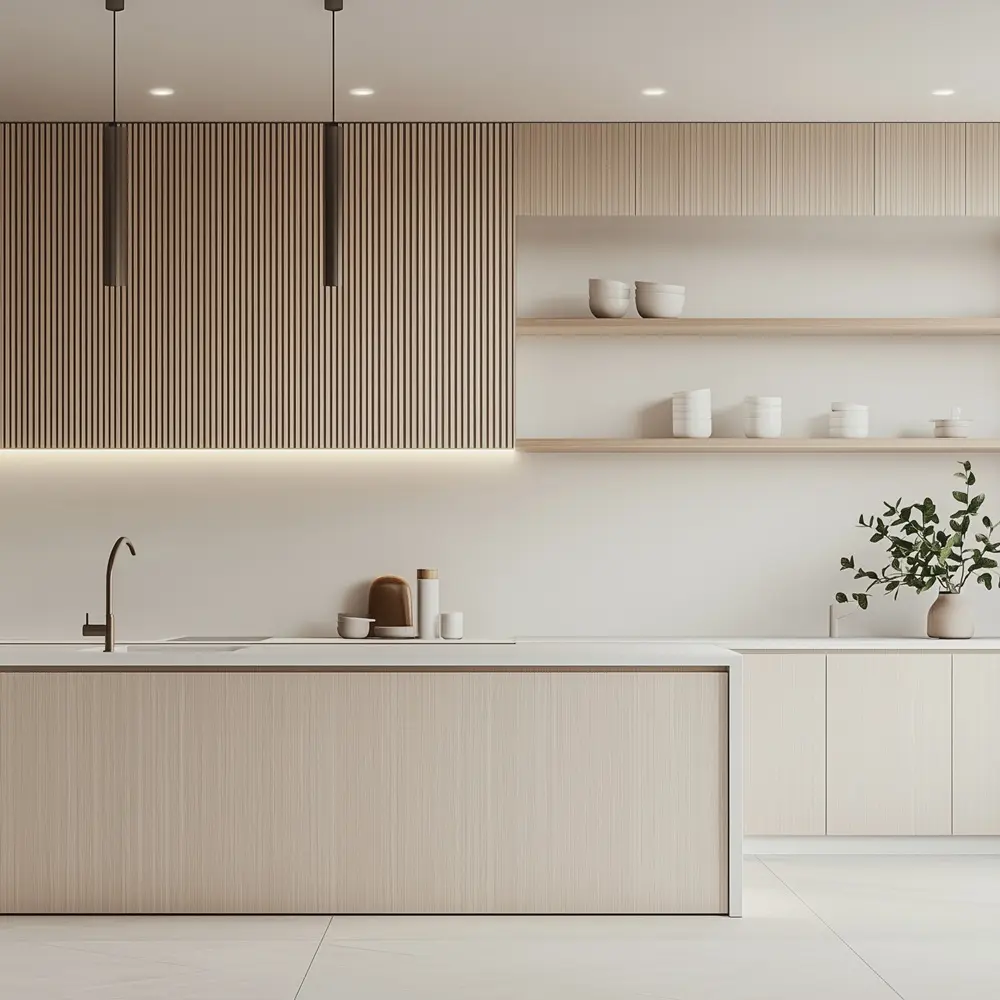
5. Using the Same Lighting for Every Room
Using the same lighting throughout the home can create an imbalance, making some spaces feel too harsh and others too dim for their intended purpose. Instead, lighting should be tailored to the specific function and mood of each room.
For instance, relaxation areas like the living or dining room thrive with warm, ambient lighting that fosters a cozy, inviting atmosphere. In contrast, workspaces such as kitchens or home offices require brighter, task-oriented lighting for functionality. A dimly lit kitchen may look aesthetically pleasing, but it can make food preparation difficult. To enhance both style and practicality, incorporate under-cabinet LED strips, recessed ceiling lights, and pendant lights over countertops to ensure sufficient illumination where it's needed most.
6. Relying Too Much on Harsh, Direct Lighting
Harsh, direct lighting can create an uninviting atmosphere and disrupt the soft, tranquil essence of Japandi design. Instead of relying on bright, exposed light sources, aim for a balanced interplay of light and shadow using diffused and indirect lighting techniques.
For example, in a living room, a single overhead fixture may cast stark shadows and create an unbalanced feel. Instead, blend various light sources such as wall-mounted fixtures, floor lamps with linen shades, and hidden cove lighting to distribute illumination evenly. This approach highlights textures like wood grain and woven fabrics while ensuring a relaxed, harmonious environment.
7. Choosing Ornate or Overly Decorative Fixtures
Japandi design emphasizes simplicity and functionality, so ornate or overly decorative lighting fixtures can detract from the clean, minimalist aesthetic. Choose simple, elegant lighting pieces that blend seamlessly with the room's overall design without overwhelming the space.
For example, in a dining area, an oversized chandelier with intricate detailing may feel too extravagant for a Japandi-inspired space. Instead, a simple wooden or paper pendant light with a soft, diffused glow would maintain the understated elegance while complementing the organic materials in the room. A large, dome-shaped pendant lamp made from natural rattan or washi paper would provide a sculptural element without being overly ornate.
Poor: Fancy lighting overwhelming the space
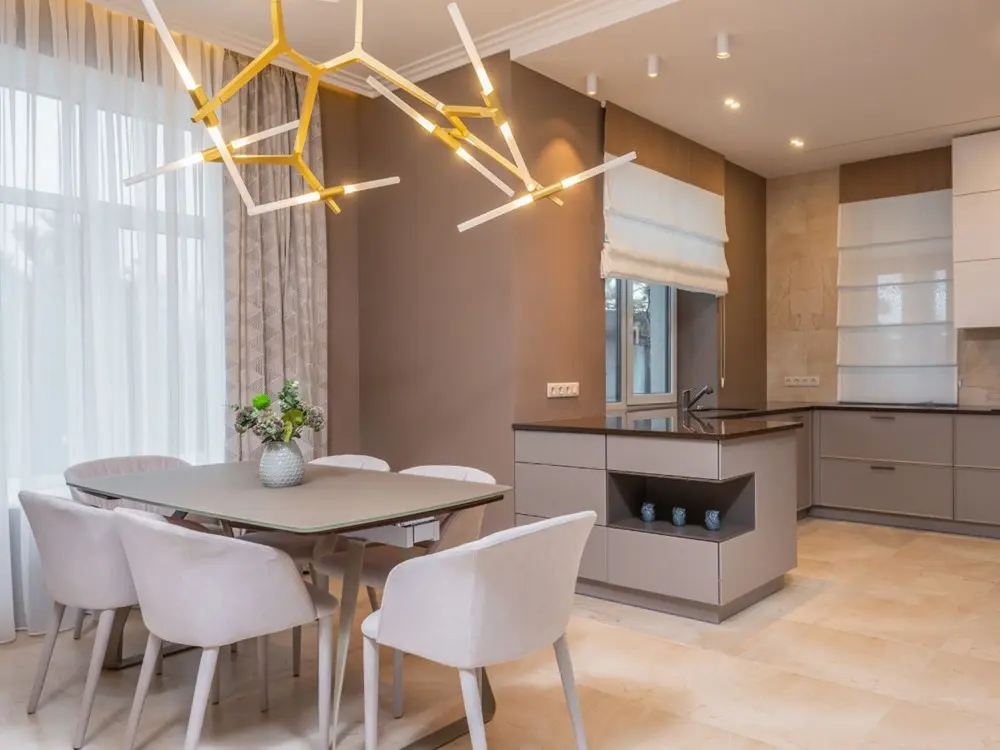
Good: Simple and elegant lighting
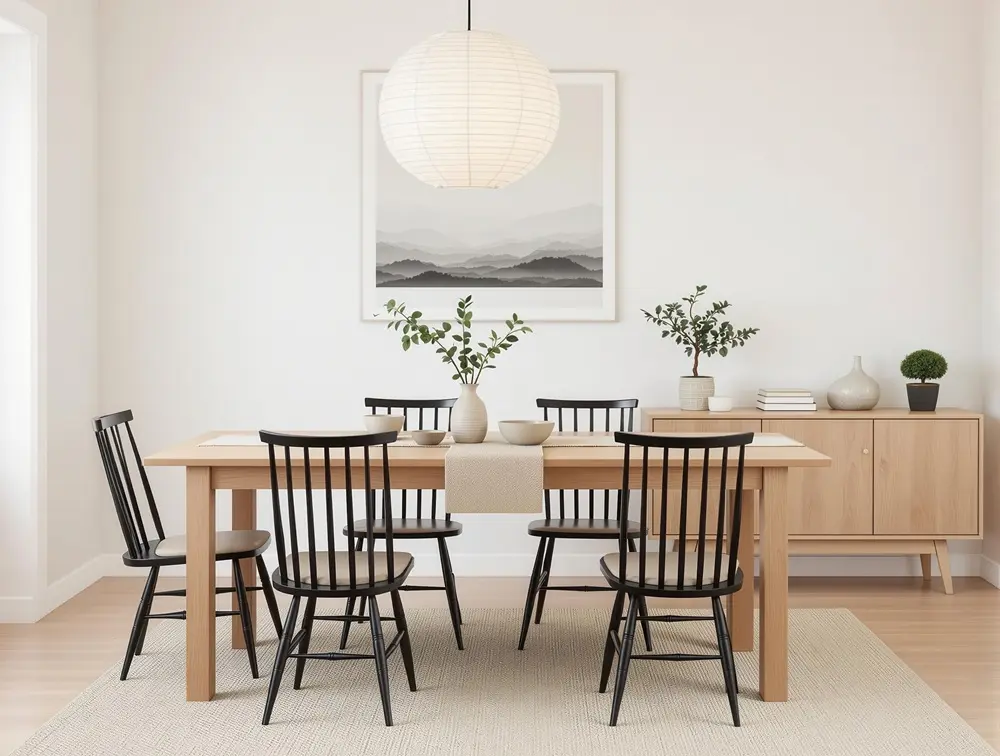
Light, Balance, and Warmth: The Essence of Japandi Illumination
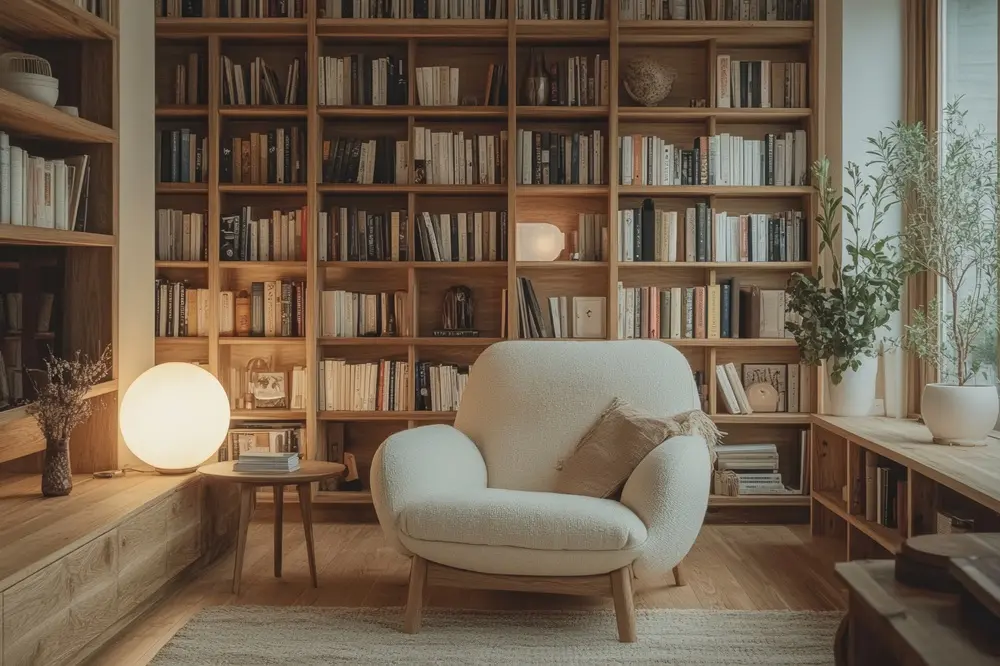
Japandi lighting is a key element in creating a tranquil, balanced, and harmonious environment. By focusing on warm, soft lighting, minimalist designs, and natural materials, and incorporating layered lighting techniques, spaces can be transformed into peaceful retreats. Thoughtful attention to light distribution, dimmable options, and hidden or indirect lighting further enhance the inviting atmosphere. To preserve the serene Japandi vibe, it's essential to avoid common mistakes such as harsh blue lighting, overusing pendant lights, or mixing inconsistent color temperatures. With these considerations in mind, Japandi lighting helps cultivate a space that blends beauty, function, and tranquility.

